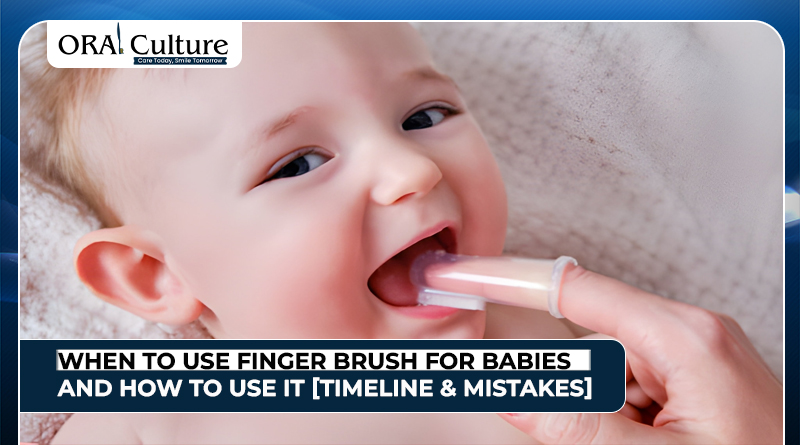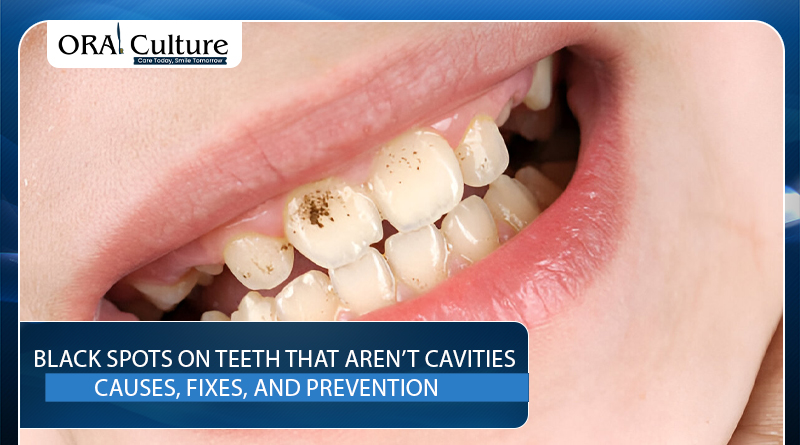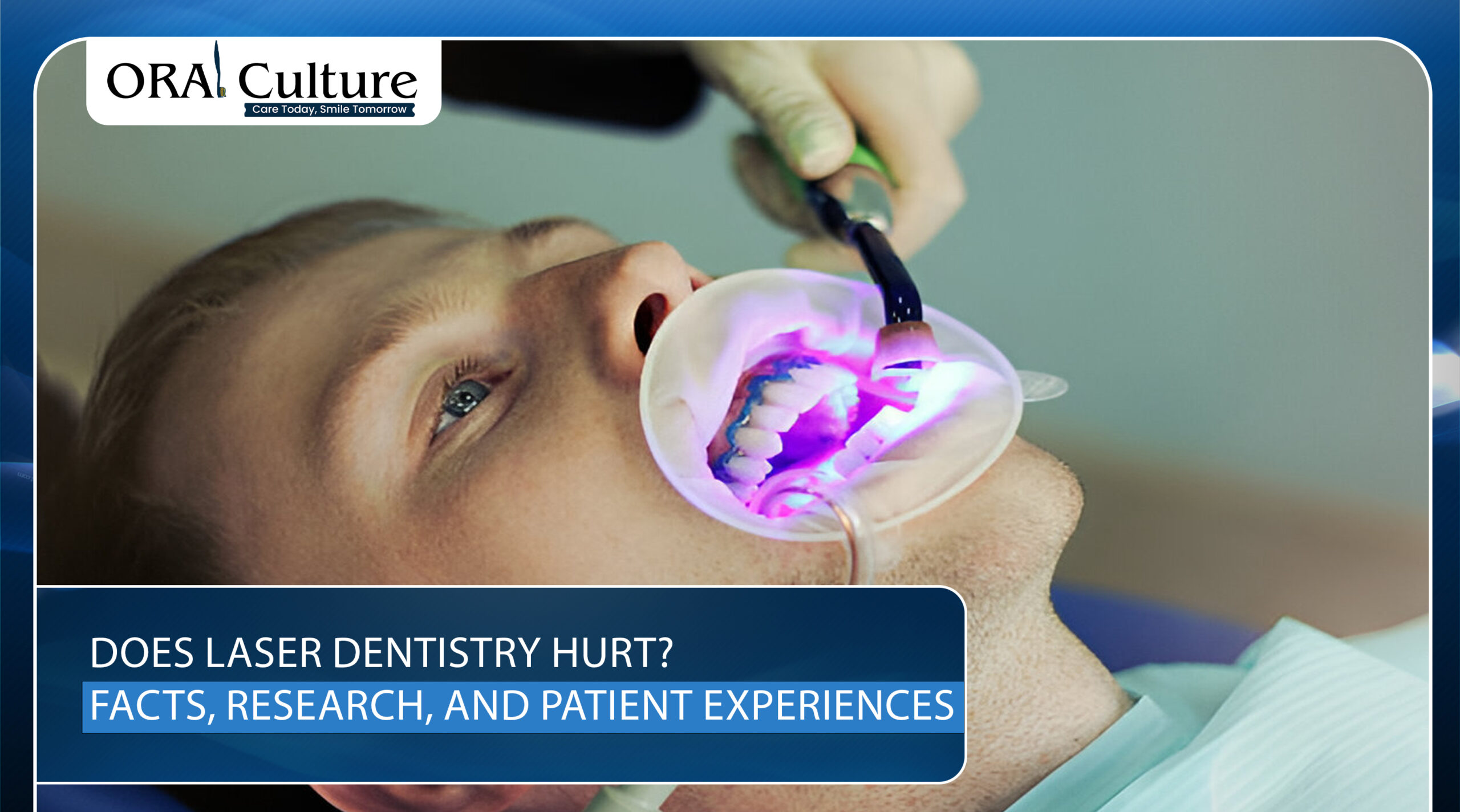Not every black spot on your teeth means you’ve got a cavity. Sometimes it’s just a stain, tartar build-up, or even your tooth’s natural shape. Cavities are only one possible reason, and assuming the worst can cause unnecessary stress. The truth is a lot of these marks are cosmetic or fixable with a simple cleaning.
If you have noticed spots and aren’t sure what’s happening, you can always find guidance at Oral Culture.
Why Do Black Spots Appear If They Aren’t Cavities?
Teeth go through a lot. Food, drinks, habits, and even genetics all leave their mark. And sometimes, those marks look like black dots or lines. Below are the most common reasons behind them.
1. Stains from Everyday Stuff
Coffee, tea, red wine, soda, and even dark berries can leave pigments behind. These pigments seep into the tiny pores of your enamel and create spots.
- If you drink iced coffee daily, those little black or brown marks aren’t shocking; they’re stains.
- Smokers deal with this a lot too. Nicotine and tar are notorious for turning teeth dark.
2. Tartar Build-Up
Plaque is the soft layer of bacteria on your teeth. Skip flossing, and it hardens into tartar. Once tartar sets, it can darken and turn black over time. No matter how hard you scrub at home, it won’t come off, you’ll need a dental cleaning.
And if you’ve ever noticed that your gums bleed when flossing, it’s often linked to this same plaque and tartar buildup.
Cleveland Clinic confirms that sugary foods/drinks contribute to plaque (which hardens into tartar), and that smoking or using tobacco products raises the risk of having more tartar.
3. Deep Tooth Grooves
Some teeth are born with grooves and pits, especially molars. These grooves naturally look darker because they trap tiny particles and shadows. Even if the enamel is totally healthy, those pits can make the tooth look “spotted.”
4. Old Fillings and Dental Work
Amalgam (silver) fillings can darken with age. Sometimes the tooth around it absorbs metal particles, leaving a blackish halo. It’s not decay, it’s just chemistry doing its thing.
5. Trauma or Injury
Ever chipped a tooth or got hit in the mouth? The inside of the tooth (the pulp) can bleed. Over time, this makes the enamel look darker or spotty. Even though it’s not a cavity, it’s still something a dentist should check out.
6. Medications and Mouthwash
Iron supplements, antibiotics, and mouth rinses like chlorhexidine can stain teeth. These stains usually look patchy and dark, but they don’t mean your enamel breaks down.
Curious why rinses sometimes sting? Read about why mouthwash burns and how it affects your oral health.
How do you tell if it’s a cavity or just a spot?
Not every black spot = panic mode. Here’s how to spot the difference:
- Probably not a cavity if: it’s smooth, flat, hasn’t changed in size, and doesn’t hurt.
- Might be a cavity if: it feels rough, gets bigger, or makes the tooth sensitive to cold/sweet foods.
The bottom line is that only a dentist can give you a sure answer. But these signs help you know when it’s urgent and when it’s just cosmetic.
Treatment Options That Really Work
Different causes need different fixes. Here’s the breakdown:
1- Surface Stains
Whitening toothpaste or professional polishing can clear them up. Think of it like exfoliating your teeth.
2- Tartar Build-Up
Only a dental cleaning will get rid of it. Dentists use special tools to scrape tartar off—no DIY shortcuts here.
3- Deep Grooves
Sealants are a good option. They’re like a protective coating that seals the pits so food and stains don’t settle inside.
4- Old Fillings
Your dentist can replace them with tooth-colored fillings if they look messy or dark. Instant glow-up.
5- Trauma
Sometimes root canal therapy is needed if the tooth is dark because of internal bleeding. But in minor cases, cosmetic whitening might be enough.
How to Prevent Black Spots (Without Overthinking It)
6- Brush and Floss Consistently
The most boring advice is also the most effective. Brushing twice a day and flossing once a day will result in way fewer spots.
7- Rinse After Staining Foods
Not saying give up coffee or berries forever. But swishing water after drinking or eating them helps keep stains off.
8- Quit Smoking or Vaping
Tobacco is brutal on enamel color. Even vaping juices with nicotine can leave residue. If you’re serious about clean teeth, cutting this habit helps big time.
9- Regular Cleanings
Even if you brush perfectly, tartar sneaks in. Seeing a dentist every six months keeps it from becoming stubborn black patches.
10- Use a Straw for Drinks
Sodas, iced coffee, or sports drinks hit your front teeth directly when you sip. A straw keeps liquids from sitting on enamel too long.
Final Thoughts
Black spots on teeth don’t always equal cavities. Sometimes it’s your morning coffee, old fillings, or tartar hanging around. Other times, it’s natural grooves that just look darker. The trick is knowing when it’s harmless and when it needs attention.
Don’t stress, but don’t ignore them either. Book a quick check-up and let a dentist figure it out. Most cases are easy fixes and won’t require major treatment.
Want more simple guides to oral health? Check out OralCulture.com and keep your teeth in check.
People Also Ask
1. Can black spots disappear on their own?
Some surface stains can fade with regular brushing or a professional cleaning. But tartar buildup and discoloration from fillings won’t go away without dental treatment.
2. Are black spots always something serious?
Not always. Many black spots are just stains or natural grooves in the teeth. Still, some can be early signs of cavities, so it’s best to have them checked by a dentist.
3. How do dentists remove black spots?
Treatment depends on the cause. Dentists may polish away stains, clean off tartar, replace old fillings, or use whitening treatments to restore the natural tooth color.
4. Can children get black spots that aren’t cavities?
Yes. Kids can develop black spots from iron supplements, certain drinks, or the natural shape of their baby teeth. These aren’t always cavities but should still be monitored.





